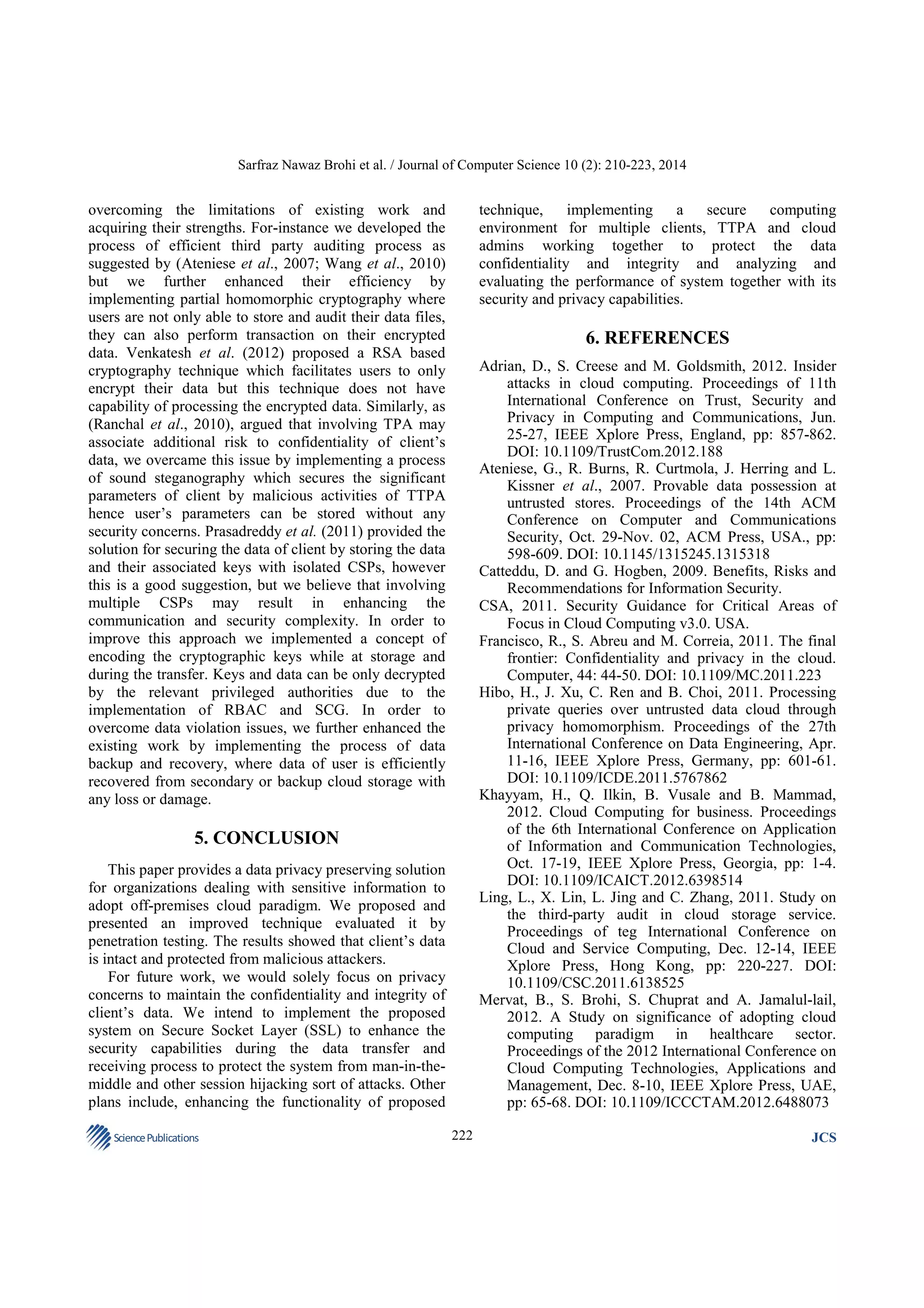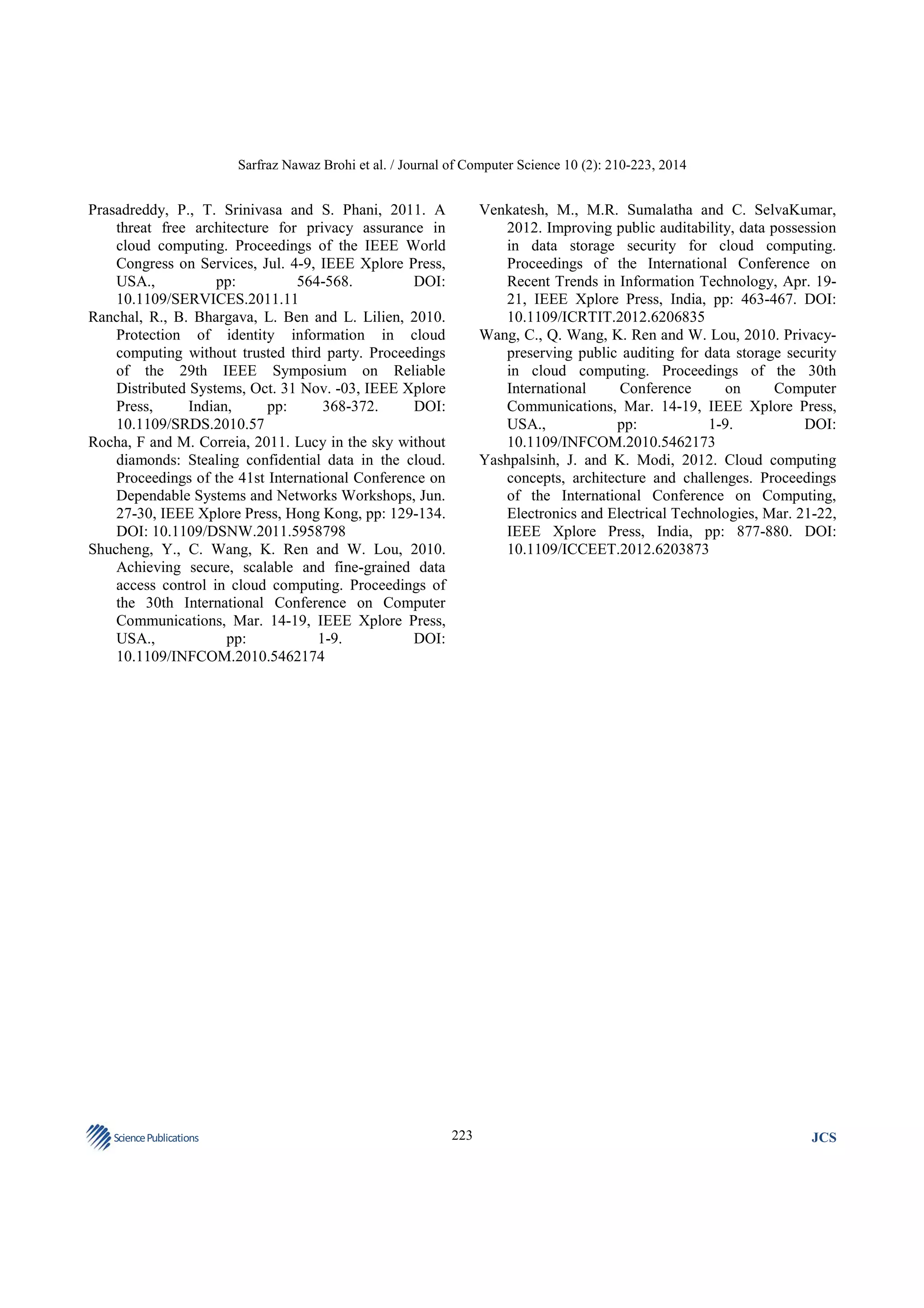This document discusses the design and implementation of a privacy-preserving cloud storage solution to address security and privacy concerns in cloud computing, particularly for sensitive industries. It introduces a technique that combines resilient role-based access control, partial homomorphic cryptography, and third-party auditing, aiming to provide organizations with control over their data while ensuring confidentiality and integrity. The proposed system architecture involves multiple stakeholders, including clients and trusted third-party auditors, with an emphasis on efficient data handling and protection against both external and internal threats.

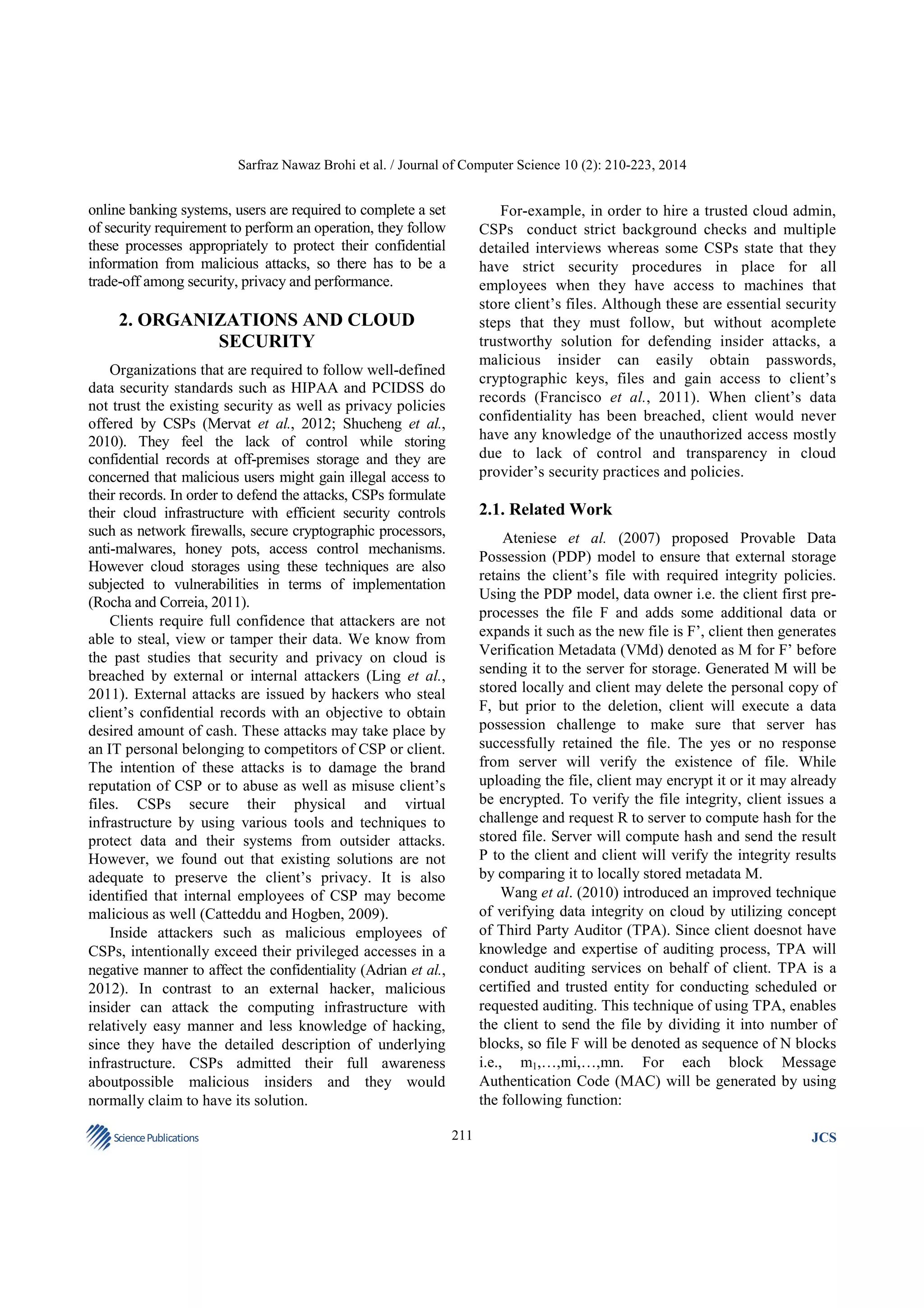
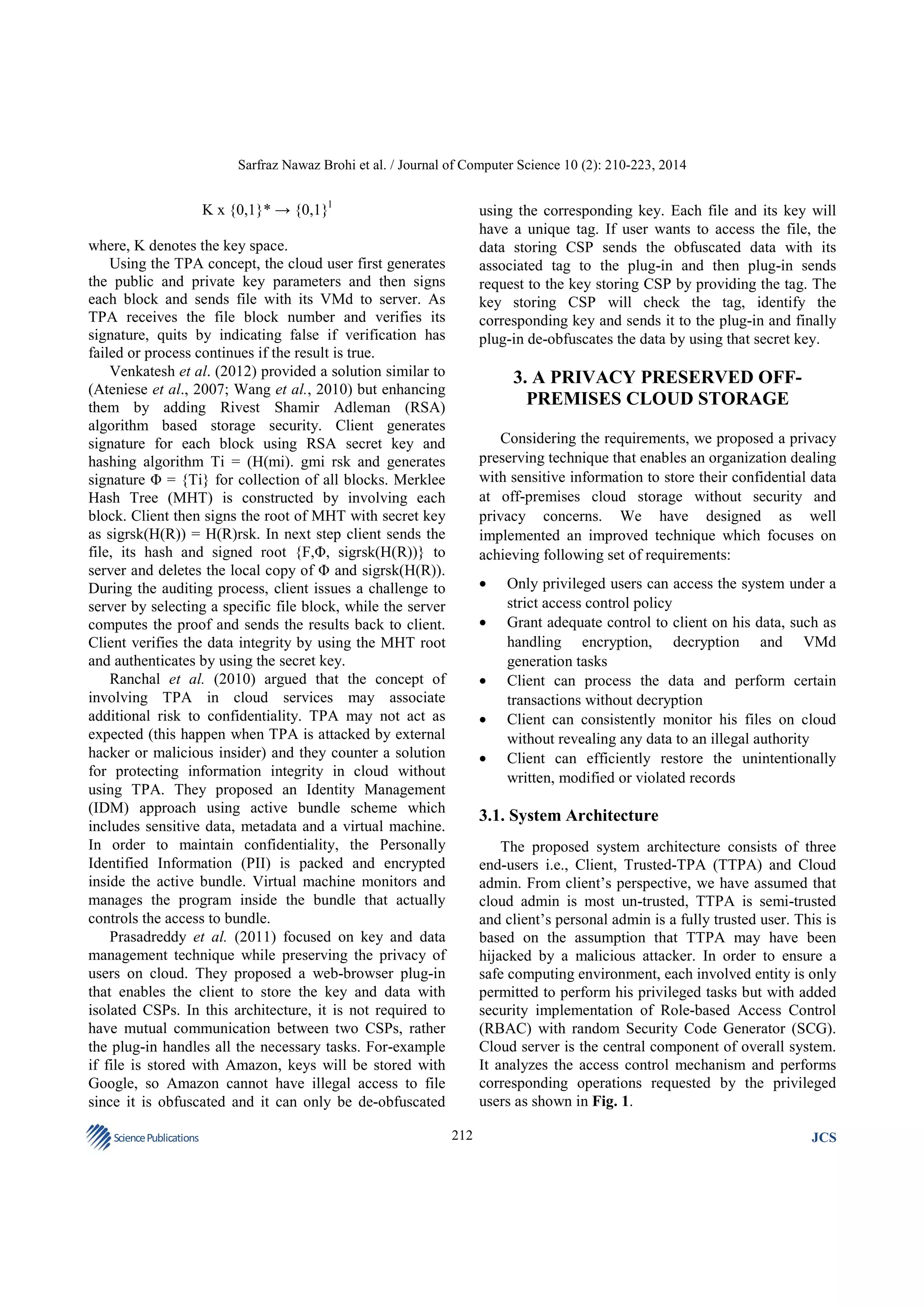

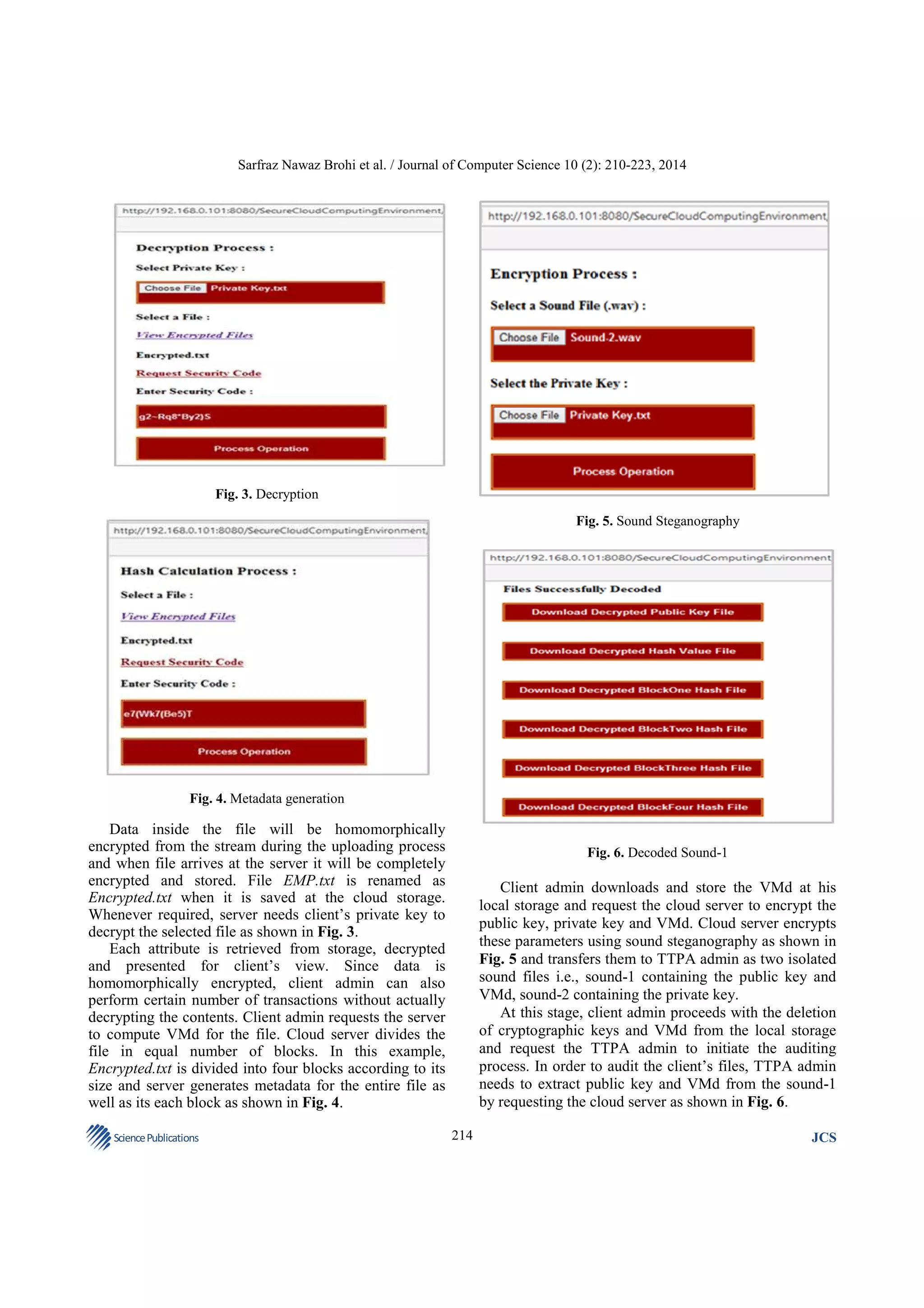
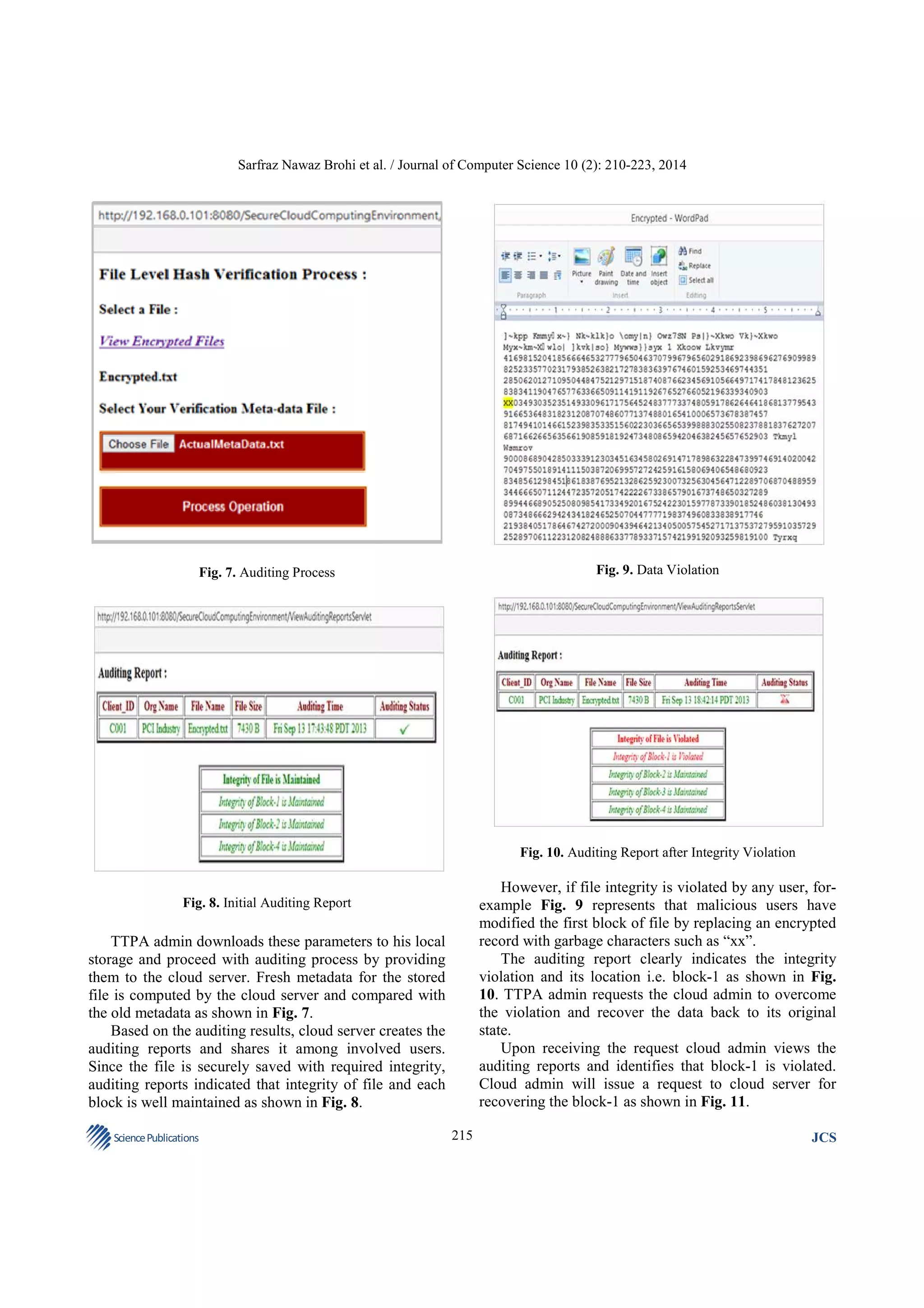
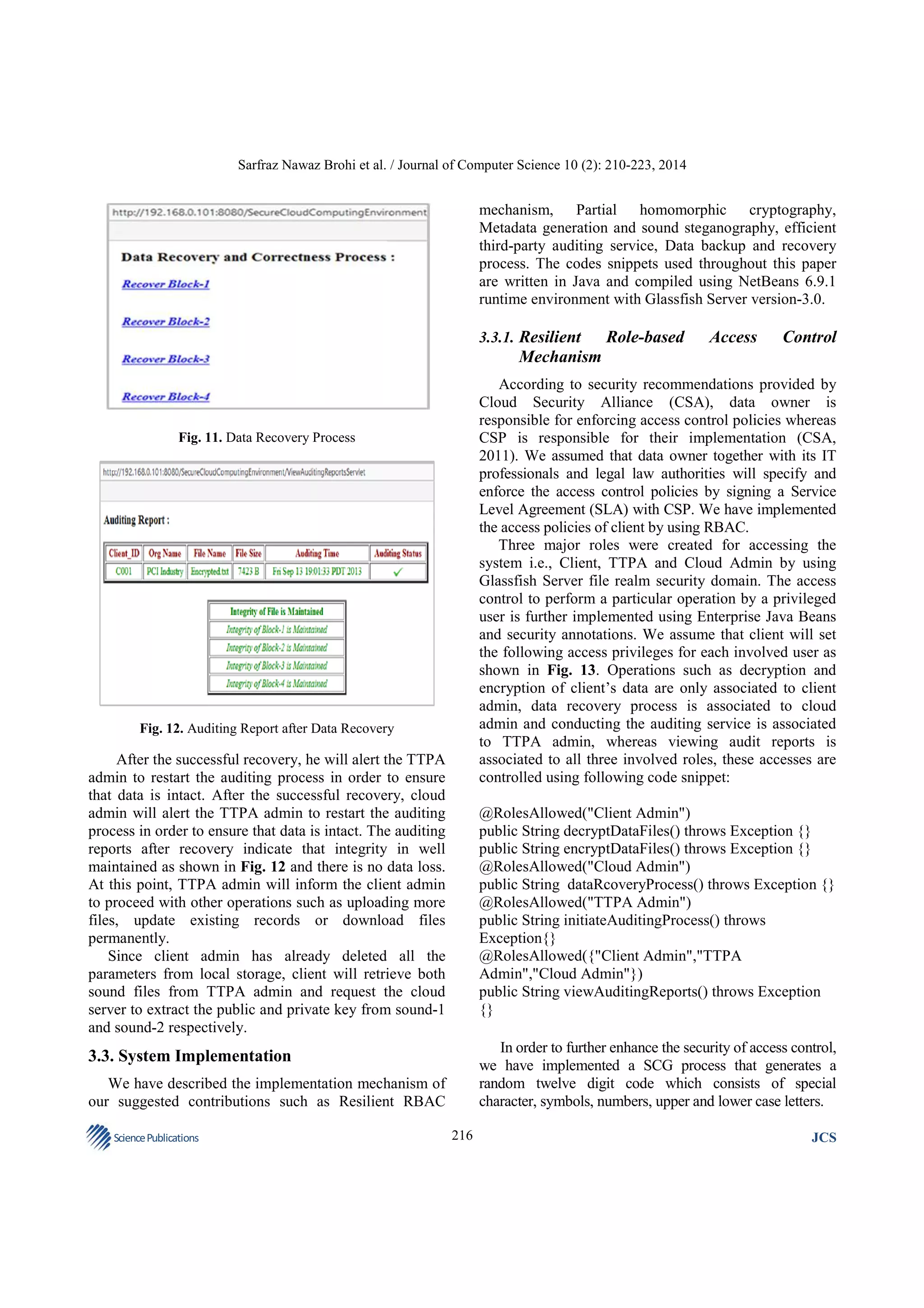
![Sarfraz Nawaz Brohi et al. / Journal of Computer Science 10 (2): 210-223, 2014
Fig. 13. Role-based Access Control Privileges
The SCG was implemented using following code
snippet:
String alphaTwo;
String alphaThree;
for(int x=nc2;x<0;x++){
int alphaNum=r.nextInt(26);
alpha=alphabet[alphaNum];
number=r.nextInt(10);
String numStr=Integer.toString(number);
int symbolNum=r.nextInt(11);
alphaTwo=symbol[symbolNum];
int alphaNumTwo=r.nextInt(26);
alphaThree=alphabetTwo[alphaNumTwo];
Random r=new Random();
String
alphabet[]={"a","b","c","d","e","f","g","h","i","j","k","l"
+
"","m","n","o","p","q","r","s","t","u","v","w","x","y","z"
};
String symbol
[]={"~","!","@","$","%","^","&","*","(",")","?"};
String
alphabetTwo[]={"A","B","C","D","E","F","G","H","I","
J","K","L"
+
"","M","N","O","P","Q","R","S","T","U","V","W","X","
Y","Z"};
String alpha;
int number;
int c=6;
int c2=c/2;
int nc2=0-c2;
String finalCode="";
Science Publications
finalCode=finalCode+alpha+numStr+alphaTwo+alphaT
hree;
}
All transaction such as decryption or auditing cannot
proceed unless accurate security code has been requested
and provided by the authorized user. Once the code is
requested, it will be generated and sent via email or SMS to
the appropriate user to proceed with the transaction. On the
successful entry of security code, system will perform the
operation or else user needs to request a fresh code.
217
JCS](https://image.slidesharecdn.com/designandimplementationofaprivacypreservedoffpremisescloudstorage-131123060137-phpapp01/75/Design-and-implementation-of-a-privacy-preserved-off-premises-cloud-storage-8-2048.jpg)
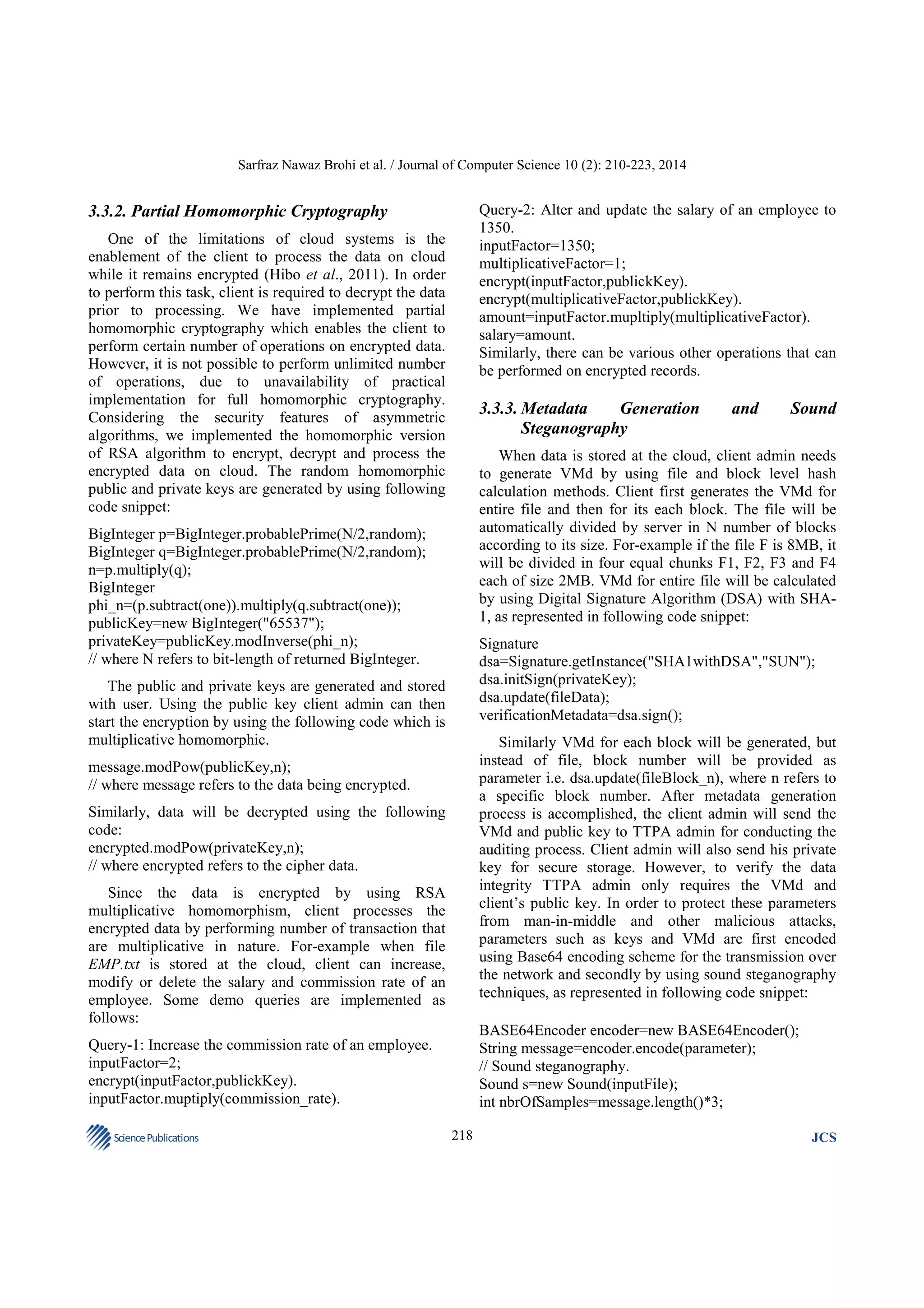
![Sarfraz Nawaz Brohi et al. / Journal of Computer Science 10 (2): 210-223, 2014
// where message refers to the value being encoded.
smoothAmpValues(s,nbrOfSamples+3);
for(int g=0;g<nbrOfSamples;g++) {
int asciiValue=(int) message.charAt(g/3);
int digit=getDecimalDigit(asciiValue,g%3);
int ampValue;
if(s.getSampleValueAt(g)>=0) {
ampValue=s.getSampleValueAt(g)+digit;
}
else{
ampValue=s.getSampleValueAt(g)-digit;
}
if(ampValue>32767){
ampValue=ampValue-10;
} if (ampValue<-32768){
ampValue=ampValue+10;
}
s.setSampleValueAt(g,ampValue);
int asciiValue=digit[0]+digit[1]*10+digit[2]*100;
if
(digit[0]==digit[1]&&digit[1]==digit[2]&&digit[2]==0)
nullReached=true;
message+=(char) asciiValue;
sampleIndex+=3;
}
BASE64Decoder decoder=new BASE64Decoder();
byte[] parameters=decoder.decodeBuffer(message);
// where message contains the encoded parameters.
Due to access control TTPA is not privileged to
decode the sound file containing the private key as it
only belongs to the access privilege of client admin.
However it will be decoded in similar fashion as other
parameters. Once the decoding process is accomplished,
TTPA admin will extract the client admin’s public key
and VMd and provide it to the server and then server will
start the process of calculating the fresh metadata by
generating the digital signature for each block and the
entire file as follows:
With the completion of steganography process, two
encoded sound files will be created, sound-1 contains the
public key and VMd and sound-2 contains the private
key. TTPA admin is only privileged to decrypt the
sound-1, since private key belongs to the client admin
and it is just sent for secure storage.
sigNew=Signature.getInstance("SHA1withDSA","SUN"
);
sigNew.initVerify(publicKey);
FileInputStream fis=new FileInputStream(fileName);
BufferedInputStream bufin=new
BufferedInputStream(fis);
byte[] buffer=new byte[1024];
int len;
while (bufin.available()!=0){
len=bufin.read(buffer);
sigNew.update(buffer,0,len);
};
bufin.close();
3.3.4. Efficient Third-Party Auditing Service
In order to conduct the auditing process, TTPA admin
will request the cloud server to generate fresh VMd for
client’s file stored at cloud. However, server requires
client admin’s public key and VMd from TTPA admin to
generate the auditing reports. Since parameters sent by
client are encoded using sound steganography and
Base64, all parameters will be decrypted using the
following code snippet:
When new signatures are generated, TTPA admin will
request the cloud server to start a comparison process to
verify the integrity as follows:
Sound s=new Sound(filename);
SoundSample[] samples=s.getSamples();
int[] digit=new int[10];
String message="";
// where message contains the desired data decoded by
sound.
int sampleIndex=0;
boolean nullReached=false;
while (!nullReached) {
digit[0]=getDecimalDigit(samples[sampleIndex].getValu
e(),0);
digit[1]=getDecimalDigit(samples[sampleIndex+1].getV
alue(),0);
digit[2]=getDecimalDigit(samples[sampleIndex+2].getV
alue(),0);
Science Publications
boolean
verifies=signofFileorBlockNumber.verify(sigNew);
if(verifies==true){
report.write("Integrity is Maintained");
}else{
report.write("Integrity is Violated"+’n’);
}
The auditing process will be recorded and a report
will be shared among all associated entities to view the
auditing results. If TTPA report encounters integrity
219
JCS](https://image.slidesharecdn.com/designandimplementationofaprivacypreservedoffpremisescloudstorage-131123060137-phpapp01/75/Design-and-implementation-of-a-privacy-preserved-off-premises-cloud-storage-10-2048.jpg)
![Sarfraz Nawaz Brohi et al. / Journal of Computer Science 10 (2): 210-223, 2014
positive and TTPA will send success message to client
for further tasks such as downloading, uploading new
files or processing. However the data stored on cloud is
homomorphically encrypted, for the decrypted
downloading process, client needs to extract his private
key from encoded sound file.
violation, a request will be sent to cloud admin for
successful recovery of violated records from the backup
cloud storage.
3.3.5. Data Backup and Recovery Process
We assumed that client’s primary storage on cloud is
Kuala Lumpur while secondary or backup location is
New York datacenter. Under some unwanted
circumstances such as natural disasters, malicious attacks
or un-wanted modifications, data will be recovered from
the New York datacenter without any loss or leakage.
During the auditing process if TTPA admin identifies
integrity violation, it will not generate success signal for
client to move on with further process, unless data is
successfully recovered from backup storage to its state of
correctness. By viewing the auditing reports cloud admin
will initiate the backup and recovery process. If entire
file or a block is violated, it will be recovered and there
is no need to recover the un-violated records. This
process will take place by using following code snippet:
3.4. Advantages of the Proposed Technique
Data owner has sufficient degree of control over his
data since the client admin is privileged to perform
encryption, decryption and metadata generation tasks.
Performing these tasks does not require in-depth and
technical knowledge of cryptography, security or cloud
computing. An intermediate IT admin can handle these
operations efficiently. Unlike other cloud systems, client
admin is not required to encrypt the data before sending
it for cloud storage, using our system, data will be
encrypted automatically while it is being uploaded but
before it arrives to the cloud storage. Data is encrypted in
real-time directly from the stream without being stored at
any location. When data arrives at the cloud storage, it
will be fully encrypted. Similarly for the decryption
process, data is not decrypted at the CSP’s end and then
transferred to the client because this could raise the
concerns of confidentiality violation. Data will depart
from cloud storage as encrypted and it will be decrypted
in real-time from the download stream. Contents will be
downloaded or viewed once arrive at the client’s end.
With the use of RBAC and random security access
generator, client can ensure that only authorized users
are accessing the system as per their privilege, this will
provide sense of satisfaction to the client.
For performing any transaction, client admin is not
required to decrypt the records due to the
implementation of partial homomorphism cryptography
so it saves time and bandwidth cost. In order to provide
client full advantage of acquiring a cloud storage
service, using our approach client admin will store the
VMd, private and public keys with TTPA, not at their
local machine, however these parameters are encoded
and can be decrypted only by the privileged user. For
the integrity checks, TTPA will initiate an efficient
auditing process, where it will be easy to determine the
location of violated data from a huge file so as to
enable efficient recovery. During the recovery process,
cloud admin will check the auditing report to determine
the actual data that needs to be recovered instead of
recovering the entire file.
byte[] buff=new byte[size];
int bytesRead;
originalFile=new File("File.txt");
originalFileStream=new FileInputStream(originalFile);
backupFile=newFile("BackupFile.txt");
backupFileStream=new FileInputStream(backupFile);
fw=new FileWriter("Recovered.txt");
bw=new BufferedWriter(fw);
String newData;
int i=1;
while
((bytesRead=originalFileStream.read(buff,0,size))>0){
if(i<5){
if(i==1){
backupFileStream.read(buff,0,size);
newData=new String(buff);
bw.write(newData);
}else{
newData=new String(buff);
bw.write(newData);
}
}
i++;
} // end while
bw.close();
Once the violated, lost or damaged records are
recovered back, TTPA admin will re-initiate the auditing
process to verify its correctness, since data is
successfully backed up, the auditing results will be
Science Publications
220
JCS](https://image.slidesharecdn.com/designandimplementationofaprivacypreservedoffpremisescloudstorage-131123060137-phpapp01/75/Design-and-implementation-of-a-privacy-preserved-off-premises-cloud-storage-11-2048.jpg)

